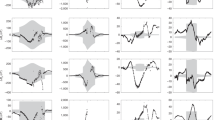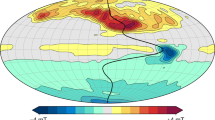Abstract
THE rotation of Jupiter is very rapid (36°/h). If its magnetospheric plasma corotates with the planet, the effect of centrifugal force on the plasma distribution will be considerable. At 6 equatorial radii from the centre (which corresponds roughly to the orbit of the satellite Io) the centrifugal force on a corotating body is eighteen times that of gravity; the two forces are equal at 2.3 radii. Thus, we may expect that the corotating plasma trapped in the magnetic field will be thrown out to those parts of the lines of force which are the most remote from the axis of rotation. There is, however, a maximum plasma density which can corotate at a given distance from the axis. The magnetic field must be able to exert enough force on the plasma to provide the required centripetal acceleration. If the plasma density is too great, it will break away, carrying the magnetic field with it. We may estimate the maximum number density of the plasma in the equatorial plane by equating the magnetic and rotational kinetic energy densities  B is the magnetic induction at radius r = Lr0, where r0 is the equatorial planetary radius and L will later be used to identify the magnetic field line on which this plasma lies. Nmax is the maximum electron or ion number density which can corotate, m the mass of an ion, Ω the angular velocity and μ0 the permeability of free space. Assuming the magnetic field to be that of a dipole aligned along the rotational axis, of induction B0 at the equatorial planetary surface, we find
B is the magnetic induction at radius r = Lr0, where r0 is the equatorial planetary radius and L will later be used to identify the magnetic field line on which this plasma lies. Nmax is the maximum electron or ion number density which can corotate, m the mass of an ion, Ω the angular velocity and μ0 the permeability of free space. Assuming the magnetic field to be that of a dipole aligned along the rotational axis, of induction B0 at the equatorial planetary surface, we find  This equation has been derived by a different method by Hines1.
This equation has been derived by a different method by Hines1.
This is a preview of subscription content, access via your institution
Access options
Subscribe to this journal
Receive 51 print issues and online access
$199.00 per year
only $3.90 per issue
Buy this article
- Purchase on Springer Link
- Instant access to full article PDF
Prices may be subject to local taxes which are calculated during checkout
Similar content being viewed by others
References
Hines, C. O., Space Sci. Rev., 3, 342 (1964).
Angerami, J. J., and Thomas, J. O., J. Geophys. Res., 69, 4537 (1964).
Roberts, J. A., and Komesaroff, M. M., Icarus, 4, 127 (1965).
Dulk, G. A., thesis, Univ. Colorado and H.A.O. (1965).
Author information
Authors and Affiliations
Rights and permissions
About this article
Cite this article
GLEDHILL, J. Magnetosphere of Jupiter. Nature 214, 155–156 (1967). https://doi.org/10.1038/214155a0
Received:
Issue Date:
DOI: https://doi.org/10.1038/214155a0
This article is cited by
-
1. Transport of Mass, Momentum and Energy in Planetary Magnetodisc Regions
Space Science Reviews (2015)
-
Determination of the electromagnetic field produced by a magnetic oblique-rotator
Astrophysics and Space Science (1983)
-
Determination of the electromagnetic field produced by a magnetic oblique-rotator
Astrophysics and Space Science (1982)
-
A survey of the outer planets Jupiter, Saturn, Uranus, Neptune, Pluto, and their satellites
Space Science Reviews (1973)
-
Electrodynamic Effects of Jupiter's Satellite Io
Nature (1968)
Comments
By submitting a comment you agree to abide by our Terms and Community Guidelines. If you find something abusive or that does not comply with our terms or guidelines please flag it as inappropriate.



